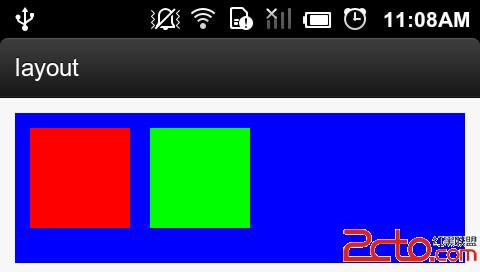Android的onLayoutlayout方法讲解
Posted
tags:
篇首语:本文由小常识网(cha138.com)小编为大家整理,主要介绍了Android的onLayoutlayout方法讲解相关的知识,希望对你有一定的参考价值。
http://www.2cto.com/kf/201404/291740.html
onLayout方法是ViewGroup中子View的布局方法,用于放置子View的位置。放置子View很简单,只需在重写onLayout方法, 然后获取子View的实例,调用子View的layout方法实现布局。在实际开发中,一般要配合onMeasure测量方法一起使用。
onLayout方法:
|
1
2
3
|
@Overrideprotected abstract void onLayout(boolean changed, int l, int t, int r, int b); |
该方法在ViewGroup中定义是抽象函数,继承该类必须实现onLayout方法,而ViewGroup的onMeasure并非必须重写的。 View的放置都是根据一个矩形空间放置的,onLayout传下来的l,t,r,b分别是放置父控件的矩形可用空间(除去margin和padding 的空间)的左上角的left、top以及右下角right、bottom值。
layout方法:
|
1
|
public void layout(int l, int t, int r, int b); |
该方法是View的放置方法,在View类实现。调用该方法需要传入放置View的矩形空间左上角left、top值和右下角right、bottom
值。这四个值是相对于父控件而言的。例如传入的是(10, 10, 100, 100),则该View在距离父控件的左上角位置(10,
10)处显示,显示的大小是宽高是90(参数r,b是相对左上角的),这有点像绝对布局。
平常开发所用到RelativeLayout、LinearLayout、FrameLayout...这些都是继承ViewGroup的布局。这些布局的实现都是通过都实现ViewGroup的onLayout方法,只是实现方法不一样而已。
下面是一个自定义ViewGroup的Demo,用onLayout和layout实现子View的水平放置,间隔是20px
|
1
2
3
4
5
6
7
8
9
10
11
12
13
14
15
16
17
18
19
20
21
22
23
24
25
|
public class MyViewGroup extends ViewGroup { // 子View的水平间隔 private final static int padding = 20; public MyViewGroup(Context context, AttributeSet attrs) { super(context, attrs); // TODO Auto-generated constructor stub } @Override protected void onLayout(boolean changed, int l, int t, int r, int b) { // TODO Auto-generated method stub // 动态获取子View实例 for (int i = 0, size = getChildCount(); i < size; i++) { View view = getChildAt(i); // 放置子View,宽高都是100 view.layout(l, t, l + 100, t + 100); l += 100 + padding; } } } |
Activity的XML布局:
|
1
2
3
4
5
6
7
8
9
10
|
<relativelayout xmlns:android="http://schemas.android.com/apk/res/android" xmlns:tools="http://schemas.android.com/tools" android:layout_width="match_parent" android:layout_height="match_parent" android:padding="10dp"> <com.example.layout.myviewgroup android:layout_width="match_parent" android:layout_height="100dp" android:background="#0000ff"> <view android:layout_width="match_parent" android:layout_height="match_parent" android:background="#ff0000"> <view android:layout_width="match_parent" android:layout_height="match_parent" android:background="#00ff00"> </view></view></com.example.layout.myviewgroup></relativelayout> |
效果如图所示:

上图MyViewGroup是蓝色,两个子View分别为红色和绿色。
在自定义View中,onLayout配合onMeasure方法一起使用,可以实现自定义View的复杂布局。自定义View首先调用 onMeasure进行测量,然后调用onLayout方法,动态获取子View和子View的测量大小,然后进行layout布局。
以上是关于Android的onLayoutlayout方法讲解的主要内容,如果未能解决你的问题,请参考以下文章